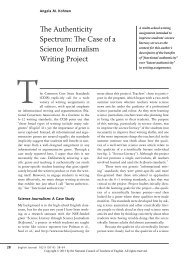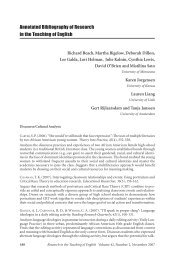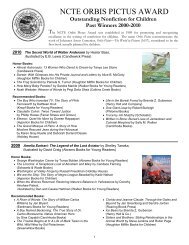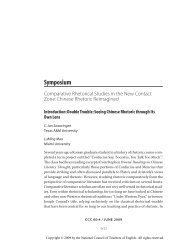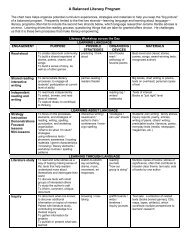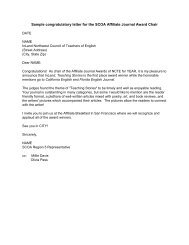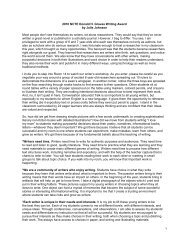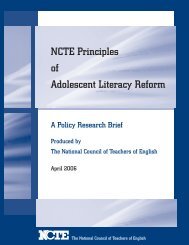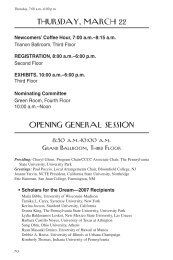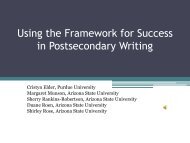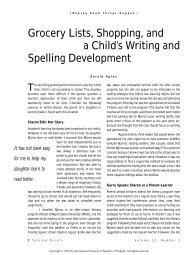Annotated Bibliography of Research in the Teaching of English
Annotated Bibliography of Research in the Teaching of English
Annotated Bibliography of Research in the Teaching of English
- No tags were found...
Create successful ePaper yourself
Turn your PDF publications into a flip-book with our unique Google optimized e-Paper software.
<strong>Annotated</strong> <strong>Bibliography</strong> 233critical th<strong>in</strong>k<strong>in</strong>g and to promote writ<strong>in</strong>g onl<strong>in</strong>e as both process (discussion) and product (documentto be assessed).BLACK, R. W. (2005). Access and affiliation: The literacy and composition practices <strong>of</strong> <strong>English</strong>languagelearners <strong>in</strong> an onl<strong>in</strong>e fanfiction community. Journal <strong>of</strong> Adolescent & Adult Literacy,49(2), 118-128.Analyzes how a fanfiction site devoted to <strong>the</strong> anime series Card Captor Sakura serves to helpELL students build social connections with o<strong>the</strong>r site users and develop <strong>the</strong>ir writ<strong>in</strong>g throughpeer feedback. F<strong>in</strong>ds <strong>in</strong>stances <strong>of</strong> positive, constructive feedback to writ<strong>in</strong>g, <strong>the</strong> development <strong>of</strong>a sense <strong>of</strong> community membership, and <strong>in</strong>tolerance to flam<strong>in</strong>g practices. Suggests <strong>the</strong> value <strong>of</strong>provid<strong>in</strong>g students with supportive audiences found on <strong>the</strong>se sites.HOLMES, M., PAPPER, R., POPOVICH, M., & BLOXHAM, M. (2006). Concurrent media exposure. Muncie,IN: Center for Media Design, Ball State University. Retrieved July 5, 2006 from http://www.bsu.edu/cmd/conmedexp/In contrast to <strong>the</strong> usual survey analyses <strong>of</strong> media use, observes 400 people’s 5,000 hours <strong>of</strong>actual media uses <strong>in</strong> <strong>the</strong>ir homes <strong>in</strong> Muncie, Indiana. F<strong>in</strong>ds high levels <strong>of</strong> “concurrent mediaexposure” (CME) due to <strong>the</strong> <strong>in</strong>creased <strong>in</strong>terest <strong>in</strong> media “multitask<strong>in</strong>g.” Notes how commonCME is, how much <strong>of</strong> <strong>the</strong> media day it occupies, and what media are regularly comb<strong>in</strong>ed <strong>in</strong>concurrent exposures. Among a range <strong>of</strong> f<strong>in</strong>d<strong>in</strong>gs, reports that TV-view<strong>in</strong>g is commonly comb<strong>in</strong>edwith o<strong>the</strong>r media, with TV and <strong>the</strong> Web be<strong>in</strong>g <strong>the</strong> most common CME pair. When experiencedsimultaneously with TV view<strong>in</strong>g, radio, or <strong>the</strong> Internet, magaz<strong>in</strong>es and newspapersdemand <strong>the</strong> most selective attention, suggest<strong>in</strong>g that pr<strong>in</strong>t media requires more attention relativeto o<strong>the</strong>r background media. These CME pair<strong>in</strong>gs vary with different age groups <strong>of</strong> <strong>the</strong>media users. Suggests <strong>the</strong> need to study <strong>the</strong> <strong>in</strong>fluence <strong>of</strong> CME multitask<strong>in</strong>g on people’s understand<strong>in</strong>g<strong>of</strong> media texts.KUIPER, M. V., & TERWEL, J. (2005). The Web as an <strong>in</strong>formation resource <strong>in</strong> K-12 education:Strategies for support<strong>in</strong>g students <strong>in</strong> search<strong>in</strong>g and process<strong>in</strong>g <strong>in</strong>formation. Review <strong>of</strong> Educational<strong>Research</strong>, 75(3), 285-328.Reviews research on students’ database searches. F<strong>in</strong>ds that students are <strong>of</strong>ten attempt<strong>in</strong>g t<strong>of</strong><strong>in</strong>d “correct answers” or specific <strong>in</strong>formation related to a question as opposed to know<strong>in</strong>g howto use or syn<strong>the</strong>size <strong>in</strong>formation to address a question or topic, browse <strong>in</strong> an unsystematicmanner without any def<strong>in</strong>ed sense <strong>of</strong> purpose or direction, and have difficulty judg<strong>in</strong>g <strong>the</strong>validity or reliability <strong>of</strong> <strong>in</strong>formation on a site. Suggests that students need to be cont<strong>in</strong>ually selfmonitor<strong>in</strong>gto determ<strong>in</strong>e if <strong>the</strong> <strong>in</strong>formation <strong>the</strong>y are acquir<strong>in</strong>g addresses <strong>the</strong>ir questions. And,as <strong>the</strong>y are navigat<strong>in</strong>g hypertext l<strong>in</strong>ks on sites, <strong>the</strong>y need to critically reflect on <strong>the</strong> <strong>in</strong>formationso that <strong>the</strong>y are purposefully mak<strong>in</strong>g choices to click on certa<strong>in</strong> l<strong>in</strong>ks.LEWIS, C., & FABOS, B. (2005). Instant messag<strong>in</strong>g, literacies, and social identities. Read<strong>in</strong>g <strong>Research</strong>Quarterly, 40(4), 470-501.Exam<strong>in</strong>es <strong>the</strong> functions <strong>of</strong> Instant Messag<strong>in</strong>g (IM) among seven youths who regularly use it tounderstand what functions IM served <strong>in</strong> participants’ lives and how <strong>the</strong>ir social identities shapedand were shaped by it. Conducted <strong>in</strong>terviews, videotaped IM sessions, and adapted a verbalreport<strong>in</strong>g procedure to document <strong>the</strong> IM strategies used. Us<strong>in</strong>g analysis based <strong>in</strong> grounded<strong>the</strong>ory, found that participants manipulated <strong>the</strong> tone, voice, word choice, and subject matter <strong>of</strong><strong>the</strong>ir messages to fit <strong>the</strong>ir communication needs, negotiat<strong>in</strong>g multiple narratives <strong>in</strong> <strong>the</strong> process.On <strong>the</strong> level <strong>of</strong> social networks, participants designed <strong>the</strong>ir practice to enhance social relationshipsand statuses across contexts.MARSH, J. (2006). Popular culture <strong>in</strong> <strong>the</strong> literacy curriculum: A Bourdieuan analysis. Read<strong>in</strong>g<strong>Research</strong> Quarterly, 41(2), 160-174.



